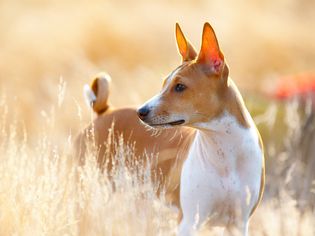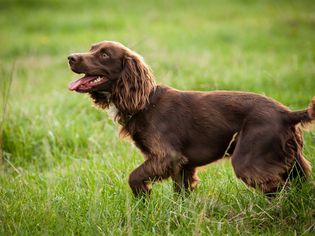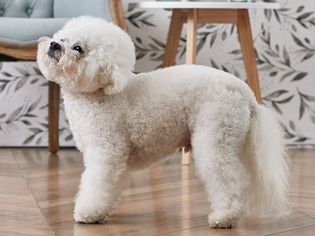The border doodle is a cross between a border collie and a poodle. Also known as the “bordoodle,” “borpoo,” or “borderpoo,” this hybrid dog breed is usually medium-sized and can have coats in various colors, including black, brown, white, as well as merle patterns. With both parent breeds being sweet, spirited, and smart, border doodles make for affectionate, fun-loving companions for families and individuals who can provide them with plenty of opportunities to put their minds and bodies to work.
Learn more about the border doodle's characteristics, history, and care needs.
Breed Overview
GROUP: Hybrid
HEIGHT: 15 to 22 inches
WEIGHT: 30 to 60 pounds
COAT: Various; medium, wavy to curly
COAT COLOR: Black, blue, chocolate, cream, fawn, gray, red, white
LIFE SPAN: 11 to 16 years
TEMPERAMENT: Intelligent, friendly, energetic, loyal, affectionate
HYPOALLERGENIC: No
ORIGIN: United States
Characteristics of the Border Doodle
As a hybrid breed, border doodles can inherit an assortment of traits from their parent breeds: the border collie and the poodle. This results in their coat and size variations to their behavior and health. Nonetheless, you can count on the border doodle to make for a great companion who’s incredibly loving, trainable, playful, and curious.
“Their friendly nature, adaptability, and eagerness to learn make them an excellent choice for a wide range of households, from active families to individuals seeking a fun-loving and loyal companion,” Jadon Marx, breeder with 2J 2K Bordoodles says. “With proper care, training, and plenty of love, a bordoodle can bring years of joy, adventure, and companionship to any home.”
| Affection Level | High |
| Friendliness | High |
| Kid-Friendly | High |
| Pet-Friendly | Medium |
| Exercise Needs | High |
| Playfulness | High |
| Energy Level | High |
| Trainability | High |
| Intelligence | High |
| Tendency to Bark | Medium |
| Amount of Shedding | Low |
History of the Border Doodle
Designer dogs, an intentional cross between two purebred dogs, skyrocketed in popularity following the labradoodle’s inception in the late 20th century. Like other poodle mixes, aka “doodle” dogs, the exact origin of border doodles is unknown.
“The first intentional bordoodle litters likely appeared in the United States around the 1990s or early 2000s,” Marx says. “Breeders quickly noticed that these dogs inherited the best qualities of their parent breeds: the intelligence and trainability of the border collie and the low-shedding, hypoallergenic coat of the poodle.”
One goal of creating hybrid dogs was to combine the best traits of two breeds and minimize potential health issues associated with purebred dogs, like genetic disorders or breed-specific health problems, Marx adds.
While border doodles aren’t recognized by the American Kennel Club (AKC), they are recognized by the American Canine Hybrid Club, Designer Kennel Club, Dog Registry of America), and Designer Breed Registry.
Border Doodle Care
Border doodles are highly intelligent and energetic dogs who are especially keen on keeping their minds sharp and their bodies active on a daily basis. Early socialization and consistent positive reinforcement training will help a border doodle thrive by building confidence and good habits. Plus, they’ll love the opportunity to learn and make their pet parents proud. While they do have low-shedding coats, they require regular grooming to keep their coats free from mats and tangles.
Exercise
With athletic parents like the border collie and poodle, it may come as no surprise that the border doodle needs to stay active on a daily basis, too. As dogs with medium-low to medium-high energy levels, they need about 45–60 minutes of exercise daily to keep both their bodies and minds in top shape, Marx says.
A few activities that are great for a border doodle’s physical activity and mental stimulation include:
- Walking or hiking
- Agility courses
- Playing fetch or Frisbee
- Interactive games (e.g. puzzle toys, hide-and-seek)
“They thrive on variety, so mixing things up helps prevent boredom,” Marx says. “Timing can vary per energy level of the individual dog, as there are variations within the breed; some puppies may naturally have a lower energy level, and some may have a higher drive or energy level.”
Keeping a border doodle active is key to a happy, well-balanced dog, he says. Without enough exercise, border doodles can become bored, possibly resulting in unwanted behaviors, like chewing or excessive barking.
Grooming
Border doodles tend to have low-to-no shedding coats due to their poodle genes, as well as some low-shedding border collie genes, Marx says. Even so, routine grooming is important to keep their coats clean and healthy.
Marx shares these grooming tips for your border doodle:
- Brush their coat 2–3 times a week to prevent tangles and mats.
- Bathe them every 4–6 weeks or as needed to keep their coat clean and fresh.
- Take them to a professional groomer—or groom them at home—every 6–8 weeks (depending on their coat type).
- Trim their nails regularly to avoid overgrowth and discomfort.
- Brush their teeth several times a week to prevent dental issues.
Border doodles may shed lightly during warmer months, requiring more frequent brushing weekly. Additionally, their coats can grow thicker during the colder months, which may require more trips to the groomer to prevent matting.
Training
The border doodle is a brainy breed who loves to learn and put their smarts to the test any opportunity they get. “Border collies and poodles are among the most intelligent dog breeds, and they excel in learning and performing tasks quickly,” Marx says. “Their eagerness to please makes training a fun and rewarding experience.”
Both parent breeds are naturally obedient for the most part. It’s important to note that they can have somewhat of an independence streak due to their working dog roots.
You can—and should—start training your puppy as soon as you bring them home, as early as 8–10 weeks old when they’re open to new experiences. Marx considers this hybrid breed “a joy to train” and shares these tips on how to help them grow into a well-mannered, confident dog:
- Train them using positive reinforcement methods.
- Start with basic commands, like sit, stay, come, and down to establish a strong foundation.
- Challenge their smarts with more advanced dog tricks, like rollover or fetching specific items.
- Introduce socialization early on to expose them to different people, pets, and environments to build their confidence and reduce anxiety.
- Stay consistent and patient to provide clear, steady guidance and provide plenty of encouragement.
Being a border collie mix, one instinctual behavior to watch for in particular is herding. Training can help prevent your border doodle from herding children or other pets.
Common Health Problems
Border collies and poodles are healthy dog breeds overall. Like any other breed, there are some hereditary health issues both may be prone to, and the same applies to border doodles. Responsible dog breeders prioritize the overall health and well-being of their dogs no matter the breed.
Some potential inherited health conditions of border doodles may include:
- Hip dysplasia
- Eye problems (e.g. collie eye anomaly, optic nerve hypoplasia, entropian corneal dystrophy, cataracts, etc.)
- Osteochondritis dissecans (OCD)
- Epilepsy
- Sebaceous adenitis
- Bloat
- Von Willebrand disease
- Addison’s disease
- Hypothyroidism
- Patellar luxation
- Cushing’s disease
Diet and Nutrition
Like all dog breeds, border doodles should eat a high-quality dog food that’s nutritionally balanced and life stage-appropriate for optimal health. Most pet parents feed two measured meals twice a day. When feeding treats, make sure they make up no more than 10% of your dog’s daily diet to prevent unwanted weight gain. Consult your veterinarian to learn more about the best type of dog food and quantity based on your border doodle’s age, size, activity level, and individual needs. Always have fresh, clean water available.
Where to Adopt or Buy a Border Doodle
If you’re looking to purchase a border doodle, expect to pay $2,500–$3,500 on average from a reputable breeder, Marx says. The cost can vary depending on factors, such as the breeder’s reputation and location, the parent’s lineage, and whether the puppy has unique coat colors or specific traits. Always look for an ethical, responsible breeder who prioritizes the health and well-being of the breed.
Because hybrid breeds like border doodles are in high demand, Marx says it’s relatively rare to come across one at a rescue or shelter. However, it’s not impossible.
If you’d like to adopt a border doodle, adoption fees are generally a few hundred dollars. Below are a few places to start your search:
- Poodle Club of America Rescue Foundation, Inc.
- California Doodle Rescue
- Doodle Rock Rescue
- Mid-Atlantic Border Collie Rescue
- All Border Collie Rescue
- Border Collies in Need
- New England Border Collie Rescue, Inc.
- Midwest Border Collie Rescue
It’s always a great idea to check your local shelters or rescues and breed-specific groups as well to see if any border doodles may be in need of a home.
Border Doodle Overview
Border doodles are whip-smart, playful, and adaptable dogs who can make excellent companions for active families, outdoor enthusiasts, and those looking for a therapy or service dog. Daily exercise and enrichment are essential to keeping these dogs happy and healthy. “A bordoodle thrives in a home that offers plenty of love, attention, activity, and mental stimulation,” Marx says.
Pros of the Border Doodle
- A great fit for active families and couples
- Loves to be around their human family members
- Relatively easy to groom
Cons of the Border Doodle
- Requires extensive daily physical activity
- Prefers not to be alone for long periods of time
- May engage in unwanted, destructive behaviors if bored
More Dog Breeds and Further Research
While on your search for your new furry friend, it’s always best to do thorough research on the border doodle to learn more about their care and whether they’re compatible with your lifestyle. Talk with border doodle owners, reputable breeders, rescue groups, and veterinary professionals for more information.
If you’re interested in breeds that are similar to the border doodle, check out:
- Old English sheepdog
- Australian shepherd (Aussie)
- Portuguese water dog
There’s a whole world of potential dog breeds out there—with a little research, you can find the right one to bring home!
- Are bordoodles a good breed?
Yes! Bordoodles are devoted, trainable, and fun canine companions who can be a great fit for families with young children and other pets.
How big does a bordoodle get?A bordoodle is a medium-sized dog who can weigh up to 60 pounds and up to 22 inches at the shoulder.
Do bordoodles shed?Because of their poodle genes and some low-shedding border collie genes, border doodles tend to have low to no shedding coats, Marx says.
Related Article








